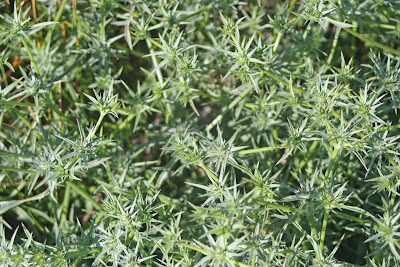We hiked out to the main vernal pool at the Plateau around 9:30am this morning to see what if anything was left of the water. The expanses of dry grasses along the Vernal Pool trail were stunningly golden-hued and full of textural contrasts.
6/26/10 Vernal Pool Trail.
I didn't expect to see any blooms this late in the season, but I was pleasantly surprised to see the Hoover's Downingia still in good form at the main vernal pool. I was even more astonished by the carpets of San Diego Button Celery in and around the receding waters. At first, I had no idea what they were (looked almost like thistles, with their bristly inflorescences), but then thistles don't grow in swampy, vernal poolly areas, so I eventually confirmed their ID through Calphotos. Really the highlight of our short trek today.
6/26/10 Hoover's/Spotted Downingia (Downingia bella). Main vernal pool.
6/26/10 Those long-horned Corriente-cross cows, doing their thing along the fringes of the main vernal pool. A lovely periwinkle field of Hoover's Downingias in the forefront.
Oh, yeah... these are the really happy cows of California. MOOWAH!
6/26/10 Hoover's Downingia (Downingia bella).
So the vernal pools are now rapidly receding, after having been inundated this past winter, thanks to El Nino.
6/26/10 Boardwalk over main vernal pool.
6/26/10 Slender Tarweed (Hemizonia fasciculata) blooming along the path to the boardwalk.
6/26/10 Slender Tarweed (Hemizonia fasciculata).
6/26/10 San Diego Button Celery (Eryngium aristulatum var. parishii). This plant is listed as rare, threatened or endangered in California and elsewhere (CNPS List 1B; 0.1: Seriously endangered in California). Main vernal pool.
6/26/10 San Diego Button Celery (Eryngium aristulatum var. parishii) along boardwalk.
6/26/10 Wine Cup Clarkia (Clarkia purpurea ssp. quadrivulnera). Vernal Pool Trail.
6/26/10 Lanceleaf Dudleya (Dudleya lanceolata). Vernal Pool Trail.
6/26/10 Lanceleaf Dudleya (Dudleya lanceolata). Vernal Pool Trail.
6/26/10 Vernal Pool Trail.
6/26/10 Acmon Blue (Plebejus acmon). Vernal Pool Trail.
6/26/10 House Wren (Troglodytes aedon). Trans Preserve Trail.
All told, in bloom today were:
California Poppy (Eschscholzia californica)
Slender Tarweed (Hemizonia fasciculata)
South Coast Morning Glory (Calystegia macrostegia)
Wine Cup Clarkia (Clarkia purpurea ssp. quadrivulnera)
San Diego Button Celery (Eryngium aristulatum var. parishii)
Hoover's Downingia (Downingia bella)
Hoover's Downingia (Downingia bella)
Lanceleaf Dudleya (Dudleya lanceolata)
Long-Beaked Filaree (Erodium botrys)


















































